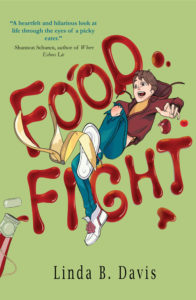“Middle Graders are Unpredictable–and the Characters we Create for Them Should be, too!”
As adults, we understand that an individual’s personality cannot be defined with one word. People are complicated and inconsistent—that’s what makes us interesting. Our neighbor yells at the kids who play on his lawn but later gushes over puppies and kittens. A happy-go-lucky waitress cries in the walk-in refrigerator where no one will notice. Kids can sometimes have difficulties recognizing and understanding these inconsistencies in themselves and others.
Recent research has shown that helping children become more aware of their own multifaceted identities and the ability to see themselves from multiple angles can promote flexible thinking and improve problem solving (Gaither, et al). Their findings suggest that learning to see ourselves from many perspectives helps to reduce rigid thinking, which can potentially promote open-mindedness and inclusiveness in a diverse society.
A quick glance at my debut middle grade novel, Food Fight, might suggest that several characters risk being reduced to stereotypes—a quirky loner, a social-climber, a pushy father, and a bully and the kid he is targeting. However, my intention was to create nuanced characters who behave inconsistently and a main character whose conflicting feelings and observations about himself, his parents, and his peers cause him great distress.
Food Fight is the story of eleven-year-old Ben Snyder who is starting middle school. Things go sideways for him right away because his extreme picky eating, which no one has been too concerned with in the past, is suddenly drawing a lot of attention—from his old friends, his weird lab partner, the girl he’s crushing on, and a bully. Before he knows it, Ben finds himself in social free fall, sliding toward the bottom of the middle school food chain. And if that’s not bad enough, he’s facing an upcoming class trip featuring three days and two nights of authentic colonial living—and authentic colonial food that Ben cannot eat.
In preparation for the trip, Ben sees a therapist who suggests that Ben may actually have an eating disorder called ARFID (Avoidant/Restrictive Food Intake Disorder). ARFID, a relatively new diagnosis, is often characterized as extreme picky eating, but the reality is actually quite serious and can cause significant medical, social, and self-esteem issues. It is described as a lack of interest in eating and/or a complete avoidance of eating particular foods based on sensory characteristics including texture, smell, and color. ARFID is often associated with other sensory disturbances, fears of choking or vomiting, and neurodivergence (although neurotypical kids and adults may also have ARFID).
People living with this condition generally say that most foods don’t seem like something they could even put in their mouth, let alone eat, which results in very restrictive diets limited to foods that feel “safe”—often processed or fast foods, which taste the same every time. And although the clinical definitions are descriptive and accurate, they often do not adequately convey the sheer psychological terror involved with ARFID—some call it a food phobia. People with ARFID do not limit themselves to foods they choose to eat—but to the only foods they can eat.
Although ARFID is a relatively rare condition, estimated to affect between three and five percent of kids, the types of obstacles it presents are universal in the world of middle graders as they confront the age-old question of How do I fit in? The bodies and minds of early adolescents are developing more rapidly than during any other stage of human development except between birth and age two. Even without significant medical or mental health issues, middle schoolers are navigating momentous social and academic challenges as well as shifting power dynamics in relationships with peers and parents—and their feelings and strategies for coping are nuanced and evolving, too.
It would be tempting to portray Ben’s bully as unilaterally bad, but he’s not. Other kids actually find him hilarious, and Ben watches on with surprise as the bully walks away from an opportunity to take revenge on another boy. Ben’s quirky lab partner carries herself with an arrogance that pushes others away, but she is loyal to Ben in ways that his own best friends are not. Ben’s father uses friendly language to shame him about his eating. Ben’s best buddy is intent on building up his own popularity but in the process has forgotten how to be a friend. And Ben himself, who could be easily portrayed as a great kid facing unfair circumstances, makes several bad decisions including lying, breaking rules, and responding to an accusation impulsively.
In a 2019 interview, Mayra Cruz, principal of a public school in Washington, DC, described middle schoolers as “consistently inconsistent” (Wong, 2019). It seems fitting that the characters in the fiction they read should be, too.
- Sarah E. Gaither, Samantha P. Fan, Katherine D. Kinzler. Thinking about multiple identities boosts children’s flexible thinking. Developmental Science, 2019: DOI:10.111/desc.12871
- Wong, A. Why is Middle School So Hard for So Many People? The Atlantic, October 7, 2019.
Published June 27th, 2023 by Fitzroy Books/Regal House
About the Book: Food Fight is the story of an overnight class trip that becomes a survival mission for an eleven-year-old boy who is learning that his super picky eating is actually an eating disorder called ARFID (Avoidant/Restrictive Food Intake Disorder).
Smart and athletic, Ben Snyder is ready to start middle school. But his super picky eating, which has never been a big deal before, is about to take him down. Suddenly everybody’s on his case about what he’s eating and what he’s not—his old friends, his new friends, his weird lab partner, the girl he’s crushing on, and a bully—and Ben finds himself in a social free fall, sliding toward the bottom of the middle school food chain.
Even worse, there’s an upcoming three-day class trip to a colonial farm. Knowing there’s no way he can handle the gag-worthy menu, Ben plans for the trip like a survival mission. Armed with new information about his eating habits, he sets out with three tactical goals: impress the girl, outsmart the bully, and avoid every single meal. But when things go sideways and epic hunger threatens to push him over the edge, Ben must decide how far he will go to fit in and if he has the courage to stand out.
About the Author: Linda B. Davis has always been curious about why we do the things we do. As a social worker in a community mental health setting, Linda became passionate about the need for accurate and accessible mental health information in children’s literature. She is a member of SCBWI and active in the Chicago writing community. She enjoys traveling, gardening, and buying more books than she can possibly read. Food Fight is her first novel.
Thank you, Linda, for honoring the complexity of middle graders!



1 thought on “Author Guest Post: “Middle Graders are Unpredictable–and the Characters we Create for Them Should be, too!” by Linda B. Davis, Author of Food Fight”